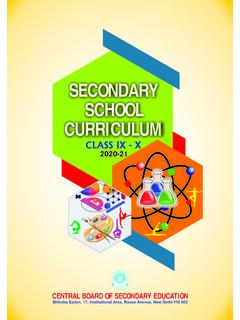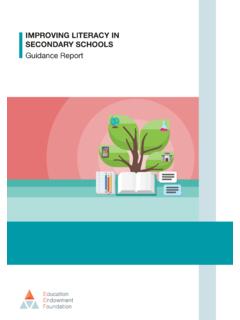Transcription of Science Notebook - Teacher Edition - gradeportfolio.com
1 Copyright Glencoe/McGraw-Hill, a division of The McGraw-Hill Companies, Fisher, ScienceCopyright Glencoe/McGraw-Hill, a division of The McGraw-Hill Companies, by the McGraw-Hill Companies, Inc. All rights reserved. Permission is granted to reproduce the materialcontained herein on the condition that such material be reproduced only for classroom use; be provided to students,teachers, and families without charge; and be used solely in conjunction with Life Science . Any other reproduction,for use or sale, is prohibited without prior written permission of the all inquiries to:Glencoe/McGraw-Hill8787 Orion PlaceColumbus, Ohio 43240-4027 ISBN 0-07-874568-3 Printed in the United States of America1 2 3 4 5 6 7 8 9 024 08 07 06 05 About the ConsultantDouglas Fisher, , is a Professor in the Department of Teacher Education at San Diego State University.
2 He is the recipient of an International Reading Association Celebrate Literacy Award as well as a Christa McAuliffe award for Excellence in Teacher Education. He has published numerous articles on reading and literacy, differentiatedinstruction, and curriculum design as well as books, such as ImprovingAdolescent Literacy: Strategies at Workand Responsive Curriculum Design in secondary Schools: Meeting the Diverse Needs of has taught a variety of courses in SDSU s Teacher -credentialing program as well asgraduate-level courses on English language development and also has taught classes in English, writing, and literacy development to secondary school Glencoe/McGraw-Hill, a division of The McGraw-Hill Companies, ScienceiiiTo the vNote-Taking viiUsing Your Science Notebook .
3 ViiiChapter 1 Exploring and Classifying LifeChapter Preview .. 14 Chapter 2 CellsChapter Preview .. 26 Chapter 3 Cell ProcessesChapter Preview .. 38 Chapter 4 Cell ReproductionChapter Preview .. 50 Chapter 5 HeredityChapter Preview .. 62 Chapter 6 Adaptations over TimeChapter Preview .. 74 Chapter 7 BacteriaChapter Preview .. 82 Chapter 8 Protists and FungiChapter Preview .. 90 Chapter 9 PlantsChapter Preview .. 102 Chapter 10 Plant ReproductionChapter Preview .. 114 Chapter 11 Plant ProcessesChapter Preview .. 122 Chapter 12 Introduction to AnimalsChapter Preview .. 134 Chapter 13 Mollusks, Worms,Arthropods, EchinodermsChapter Preview .. 148 Copyright Glencoe/McGraw-Hill, a division of The McGraw-Hill Companies, ScienceChapter 14 Fish, Amphibians,and ReptilesChapter Preview.
4 162 Chapter 15 Birds and MammalsChapter Preview .. 170 Chapter 16 Animal BehaviorChapter Preview .. 178 Chapter 17 Structure and MovementChapter Preview .. 190 Chapter 18 Nutrients and DigestionChapter Preview .. 198 Chapter 19 CirculationChapter Preview .. 210 Chapter 20 Respiration and ExcretionChapter Preview .. 218 Chapter 21 Control and CoordinationChapter Preview .. 226 Chapter 22 Regulation andReproductionChapter Preview .. 238 Chapter 23 Immunity and DiseaseChapter Preview .. 250 Chapter 24 Interactions of LifeChapter Preview .. 262 Chapter 25 The Nonliving EnvironmentChapter Preview .. 274 Chapter 26 EcosystemsChapter Preview .. 286 Chapter 27 Conserving ResourcesChapter Preview.
5 298 Academic 299 Copyright Glencoe/McGraw-Hill, a division of The McGraw-Hill Companies, SciencevAs you begin a new school year, one of the biggest challenges youprobably will encounter is getting students to read their text can overwhelm students, leaving them less likelyto read and more likely to become apathetic about believe that this Science Notebook will help students use theirtextbooks more effectively as they learn about the TeacherNote-Taking and Student SuccessThere is considerable research evidencethat addresses how students understand difficult concepts and content in has developed theScience Notebookfor Science students basedupon that research. Evidence indicates that stu-dents need to know how to take notes, usegraphic organizers, learn vocabulary, anddevelop their thinking skills by writing in orderto achieve academic ability to take and organize notes pre-dicts how well students will do in , Brobst, Graham, and Shaw (2003)showed that when students use backgroundknowledge and take notes, they are likely toperform well on tests.
6 Pauk (1974) observedthat note-taking is a critical skill for collegesuccess. Notes serve as an external storagefunction (meaning on the paper) that buildscomprehension and content understanding(Ganske, 1981). This Science Notebookis a toolthat students can use to achieve this goal. Iwould like to share some of the features ofthis Science Notebookwith you before youbegin Cornell Note-Taking SystemFirst, you will notice that the pages in theScience Notebookare arranged in two columns,which will help students organize their think-ing. This two-column design is based on theCornell Note-Taking System,developed atCornell ,Morris,andLieberman (2000) found that the CornellNote-Taking Systemimproves comprehen-sion and increases test column on the left side of the pagehighlights the main ideas and vocabulary ofthe lesson.
7 This column will help students findinformation and locate the references in theirtextbooks quickly. Students also can use thiscolumn to sketch drawings that help themvisually remember the lesson s the column on the right side of the page,students will write detailed notes about themain ideas and vocabulary. The notes theytake in this column will help them focus on theimportant information in the lesson. As stu-dents become more comfortable using theCornell Note-Taking System,they will seethat it is an important tool that helps themorganize Importance of Graphic OrganizersSecond, there are many graphic organizersin this Science organizersallow students to see the lesson s importantinformation in a visual format.
8 In addition,graphic organizers help students summarizeinformation and remember the content. I hopethat you will encourage students to use thegraphic organizers because they will help themunderstand what they are Science Teacher ,Copyright Glencoe/McGraw-Hill, a division of The McGraw-Hill Companies, ScienceResearch-Based Vocabulary DevelopmentThird, you will notice that vocabulary is introduced and practiced throughout theScience students know the meaning of the words used to discussinformation, they are able to understand that information better. Also, students aremore likely to be successful in school when they have vocabulary knowledge. Whenresearchers study successful students, theyfind that as students acquire vocabularyknowledge, their ability to learn improves(Martino and Hoffman, 2002).
9 The ScienceNotebookfocuses on learning words that arevery specific to understanding the content ofthe textbook. The Science Notebookalso high-lights general academic words that studentsneed to know so that they can understand anytextbook. These vocabulary words are basedon the Academic Word List (AWL) developedby Averil Coxhead. The AWL includes themost common 570 words found in academictexts, excluding the 2,000 general Englishwords such as the,in,and indicates that students who master the wordson Coxhead s list score significantly higher onstandardized Prompts and Note-TakingFinally, there are a number of writing exer-cises included in this Science a useful tool that helps students understandthe information that is being helps them assess what they havelearned.
10 You will see that many of the writingexercises require students to practice the skillsof good readers. Good readers make connec-tions between their lives and the text and predictwhat will happen next in the questionthe information and the authorof the text,clarifyinformation and ideas, andvisualizewhat is described in the text. Goodreaders also summarizethe information that ispresented and make inferencesor draw conclu-sions about the facts and wish you well as you begin another schoolyear. This Science Notebookis designed to helpstudents understand the information in yourscience class. The guide will be a valuable toolthat also will provide students with skills thatthey can use throughout their hope you have a successful school ,Douglas FisherReferencesFaber, J.








